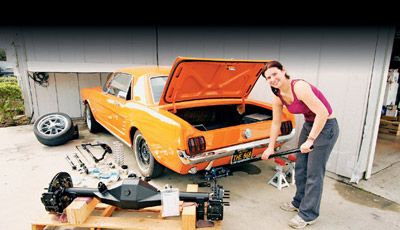
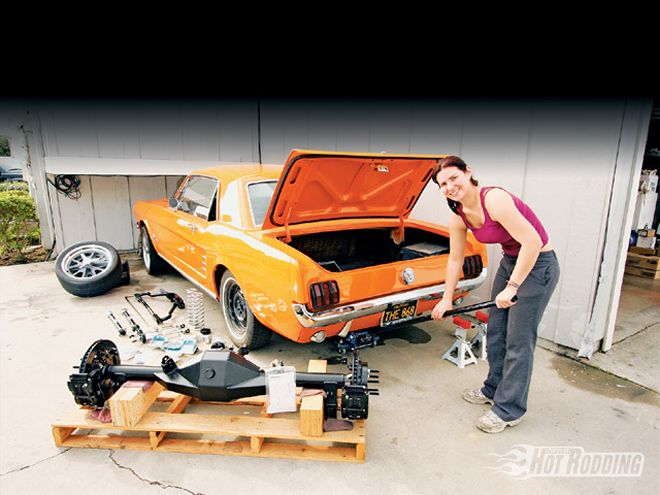
Street Fighter
This '66 Mustang is being transformed from an all-original six-cylinder cruiser, to a dual-purpose, road-race street car. To that end, we've replaced the factory drum brakes in the front with Wilwood 13-inch rotors and six-piston calipers, upgraded to a Wilwood dual-reservoir master cylinder, and converted the box-and-linkage-style steering to Total Control Product's rack-and-pinion steering, to get it closer to our goal.
Last month, we put together a Ford 9-inch rearend at Currie Enterprises to replace the one-legged, drum-brake 8-inch factory rearend, which is weaker than the stronger '67-up 8-inch. We took Chassisworks Fab9 housing and stuffed it with a Detroit TrueTrac gear-type posi, 3.50 gears, Wilwood 13-inch brakes, and Currie 31-spline axles. You can order the Fab9 housing to fit many models, or you can get a kit to retrofit your current housing to work with their suspension. This may sound like overkill for the six-cylinder currently residing between the fenders, but it is a necessary step for the 560-plus horsepower 427ci Windsor waiting in the wings. This direct-fit housing was built specially by Chassisworks to use a triangulated four-link coilover setup from Chassisworks' Total Control Products (TCP) division. TCP's canted four-bar, otherwise known as a triangulated four-link, is a street-friendly rear suspension that's built with enough adjustment for competitive racing.
The four-bar setup uses upper and lower links that have multiple mounting positions to adjust chassis antisquat and to optimize vehicle handling. Upper links are adjustable to set pinion angle and suspension preload if needed. The g-Link's lower arms are also adjustable for wheelbase variations and precise housing alignment. This kind of adjustment couldn't be possible with a traditional leaf-spring setup. This system can be used with either coilover or air springs. We chose to use the coilovers for their simple design and adjustability. With a choice of three upper and four lower mounting holes, ride height can be altered without adjusting the preload on the spring. As with all coilover systems, being able to corner weight the car with minor adjustments can yield huge improvements at the track.
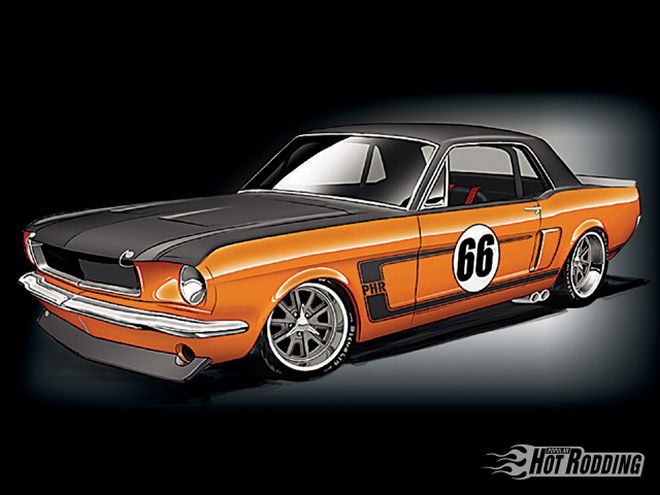
We had a choice of three different lower links, a non-adjustable link with poly bushings for smooth and quiet operation, an adjustable steel link with pivot balls at either end for maximum strength and tuneability, and billet aluminum links for weight savings--which is what we chose here. The upper links come with poly or pivot ball ends (which we chose) and both styles are adjustable.
To go with our new suspension, we opted to use TCP's adjustable-rate 5/8-inch sway bar. It has three mounting points at the end of the bar to adjust its effectiveness. Our Mustang didn't come with a rear sway bar from the factory, but I'm a big believer in them, so that's the way we're going here. The sway bar mounting points are incorporated into TCP's direct-fit housing and frame brackets, which make it an easy bolt-on.
The installation process was incredibly easy. In most cases, the words "bolt-in" or "direct-fit" have very little meaning, but these TCP components actually fit. The best advice we can give you before you start this installation is to actually read everything first, and look at all the parts. Make sure you have all the tools you need to finish the project before you begin, including a MIG welder.
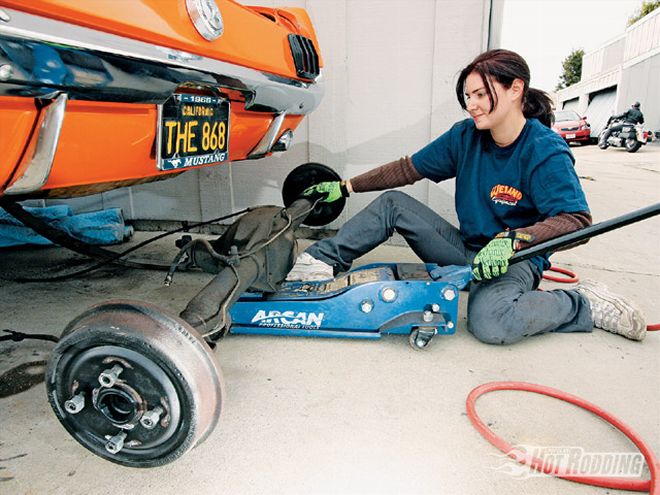 We won't go into a lot of detail on how to get the original equipment out, but keep in mind you'll have to disconnect the driveshaft, brake lines, exhaust, shocks, and leaf springs. We removed the fuel line just to be safe, and plugged the rubber line from the tank with an old spark plug.
We won't go into a lot of detail on how to get the original equipment out, but keep in mind you'll have to disconnect the driveshaft, brake lines, exhaust, shocks, and leaf springs. We removed the fuel line just to be safe, and plugged the rubber line from the tank with an old spark plug.
Four-Link Ford Fix
Total Control Products offers two different four-link rear suspensions for early Mustangs, the g-Bar and g-Link; both systems convert the leaf-spring setup in '64-70 Mustangs (and '67-70 Mercury Cougars) to a triangulated (or canted) four-link. Both systems use a bolt-in cradle to simplify installation and guarantee proper geometry, however, the difference in nomenclature is due to the g-Link's re-buildable pivot-ball bearing housings (similar in concept to a Heim joint) for its control arm joints, while the g-Bar employs a street-friendly poly bushing. The one thing that's important to remember is that the leaf spring is completely eliminated in both. This does several good things, like decouple the suspension travel from the pinion angle, and eliminate axle wrap and wheel hop associated with leaf springs. Moreover, spring rate and ride height are fully adjustable (up to 4.5 inches of adjustability), and a wide choice of coilovers are available, from single-adjustable VariShocks, to double-adjustables, and even Ride Tech's ShockWave air spring/shock combos.
Within the g-Link rear suspension family, there are additional options, such as an upgrade to billet lower control arms. Customers can choose to use their own rearend housing (either 8- or 9-inch, so long as the axle tubes are a minimum of 213/16-inch diameter), or use one of Alston's bomb-proof Fab9 housings, as we're doing here with the Street Fighter Mustang. Customers electing to use their own 8-inch housing can purchase Alston's upper control arm weld fixture, which precisely places the upper control arm mount so that it may be welded correctly. (A big plus in our book since we've had to do the exact same operation without such a fixture when we converted to a four-link on our '76 Camaro project car.) We'll also mention parenthetically that the stock 8-inch rear is super safe to about 350 hp when the stronger '67-up carrier assembly is used.
One other nice Total Control touch is the flexibility of shock mounting geometry the g-Bar and g-Link provide. This allows the user to tune the leverage ratio on the coilover for a maximum range of handling characteristics. Those opting for coilovers also have a large selection of spring rates to choose from, ranging from 110 lb/in of rate, up to 300 lb/in, with eight choices in all. One trick option you'll want to look hard at is the spring seat thrust bearing, which seats the bottom of the coil spring in a sealed Torrington bearing. This makes changing the ride height an effortless affair, as there's almost no turning resistance once the spring seat is unlocked.
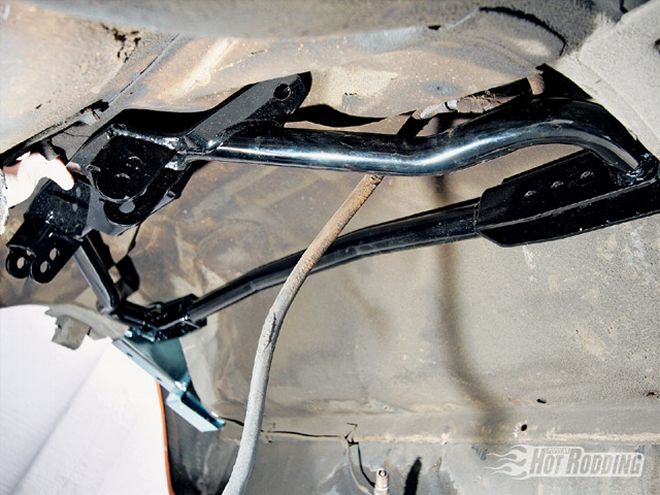
So what's all this gonna cost you? We shelled out $2,918 for the max-effort combo, but you can get into a basic g-Bar system, using your own rearend, and equipping it with single-adjustable VariShock coilovers, for about $1,739. If you've got a serious street Mustang or Cougar project going together, you may already familiar with Total Control's constellation of front suspension parts. The g-Bar and g-Link are a great complement to these pieces, and as a whole, bring Ford's 40-year-old econocar suspension into the 21st century, and then some.--Johnny Hunkins
WHERE THE MONEY WENT TCP G-Link kit $2,598 TCP sway bar $289 TCP spanner wrench $31 Total $2,918 STREET FIGHTER MUSTANG THE COST SO FAR '66 Mustang 6-cyl. coupe $3,800 Battery replacement and relocation (11/08) $299.00 Radiator and fans (12/08) $1,398.12 Spindles, front brakes, wheels, and tires (1/09) $3,067.04 Trunk rehab and tool box (2/09) $40.48 Rack and pinion steering, column, and steering wheel (4/09) $3,012.00 9-inch rear and brakes (5/09) $4,631.02 Rear suspension (current) $2,918.00 Total $19,165.66